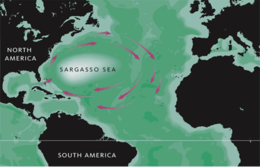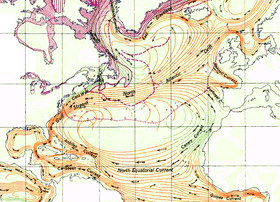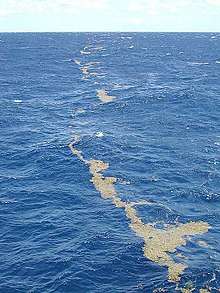Sargasso Sea


The Sargasso Sea (/sɑːrˈɡæsoʊ/) is a region of the North Atlantic Ocean bounded by four currents forming an ocean gyre.[1] Unlike all other regions called seas, it has no land boundaries.[2][3][4] It is distinguished from other parts of the Atlantic Ocean by its characteristic brown Sargassum seaweed and often calm blue water.[1]
The sea is bounded on the west by the Gulf Stream, on the north by the North Atlantic Current, on the east by the Canary Current, and on the south by the North Atlantic Equatorial Current, a clockwise-circulating system of ocean currents termed the North Atlantic Gyre. It lies between 70° and 40° W, and 20° to 35° N, and is approximately 1,100 km wide by 3,200 km long (700 by 2,000 statute miles).[5][6] Bermuda is near the western fringes of the sea.[7]
All the currents deposit the marine plants and refuse they carry into this sea, yet the ocean water in the Sargasso Sea is distinctive for its deep blue color and exceptional clarity, with underwater visibility of up to 61 m (200 ft).[8] It is also a body of water that has captured the public imagination, and so is seen in a wide variety of literary and artistic works and in popular culture.[9]
History
The naming of the Sargasso Sea after the Sargassum seaweed traces back to the early 15th-century Portuguese explorations of the Azores Islands and of the large "volta do mar" (the North Atlantic gyre), around and west of the archipelago, where the seaweed was often present.[10] However, the sea may have been known to earlier mariners, as a poem by the late 4th-century author Rufus Festus Avienus describes a portion of the Atlantic as being covered with seaweed, citing a now-lost account by the 5th-century BC Carthaginian Himilco the Navigator.[11]
In 1846, Edward Forbes hypothesized a post-Miocene land mass extending westward from Europe into the Atlantic:
| “ | If this land existed it did not extend to America (for the fossils of the Miocene of America are representative & not identical): where then was the edge or coastline of it, Atlantic-wards? Look at the form & constancy of the great fucus-bank & consider that it is a Sargassum bank. | ” |
| — Edward Forbes, from the Darwin Correspondence Project[12] | ||
Ecology

The Sargasso Sea is home to seaweed of the genus Sargassum, which floats en masse on the surface there. The sargassum is not a threat to shipping, and historic incidents of sailing ships being trapped there are due to the often calm winds of the horse latitudes.[13]
The Sargasso Sea also plays a major role in the migration of the European eel, the American eel, and the American conger eel. The larvae of both species hatch there and go to Europe or the East Coast of North America. Later in life, the matured eel tries to return to the Sargasso Sea to spawn and lay eggs. It is also believed that after hatching, young Loggerhead sea turtles use currents such as the Gulf Stream to travel to the Sargasso Sea, where they use the sargassum as cover from predators until they are mature.[14][15]
In the early 2000s, the Sargasso Sea was sampled as part of the Global Ocean Sampling survey, to evaluate its diversity of microbial life through metagenomics. Contrary to previous theories, results indicated the area has a wide variety of prokaryotic life.[16]
Pollution
Owing to surface currents, the Sargasso accumulates a high concentration of non-biodegradable plastic waste.[17] The area contains the huge North Atlantic Garbage Patch.[18]
Several nations and nongovernmental organizations have joined together to protect the Sargasso Sea.[19] These organizations include the Sargasso Sea Commission[20] established on 11 March 2014 by the governments of the Azores (Portugal), Bermuda (United Kingdom), Monaco, United Kingdom and the United States.
Bacteria that consume plastic have been found in the plastic-polluted waters of the Sargasso Sea; however, it is unknown whether these bacteria ultimately clean up poisons or simply spread them elsewhere in the marine microbial ecosystem. Plastic debris can absorb toxic chemicals from ocean pollution, potentially poisoning anything that eats it.[21]
Depictions in popular culture
The Sargasso Sea is often portrayed in literature and the media as an area of mystery.[9]
The Sargasso Sea features in classic fantasy stories by William Hope Hodgson, such as his novel The Boats of the "Glen Carrig" (1907), Victor Appleton's Don Sturdy novel Don Sturdy in the Port of Lost Ships: Or, Adrift in the Sargasso Sea, and several related short stories.[22] Jules Verne's Twenty Thousand Leagues Under the Sea describes the Sargasso Sea and gives an account of its formation.[23]
The Sargasso Sea is frequently (but erroneously) depicted in fiction as a dangerous area where ships are mired in weed for centuries, unable to escape. The Doc Savage novel The Sargasso Ogre, published in 1933, takes place in the Sargasso where descendants of Elizabethan pirates still live. The premiere episode of Jonny Quest, "Mystery of the Lizard Men," involves a spy ring operating in the Sargasso, underneath the (nonexistent) derelict ships. Hammer Film Productions' 1968 film The Lost Continent (based on a 1938 Dennis Wheatley novel, Uncharted Seas), depicts travelers lost in a Sargasso Sea infested with carnivorous seaweed, giant crustaceans, and descendants of Spanish conquistadors ruling over other trapped people, descendants of those mired in the weed centuries before. These depictions are parodied in The Venture Bros. season 1 episode "Ghosts of the Sargasso", set in the overlapping area of sea of the Sargasso Sea and the Bermuda Triangle, which depicts supposed pirates whose ship was stuck in the sargassum for a decade and the ghost of the pilot of an experimental aircraft which crashed into the sea in 1969.[24]
Fred Andrew's mystery novel, Plato's Pond, features the fictitious land of Gaia, which is a continent in the middle of the Sargasso Sea.[25]
Perhaps the most famous novel featuring its name is Jean Rhys's Wide Sargasso Sea, a rewriting of Charlotte Brontë's Jane Eyre from Bertha Mason's point of view.[26]
More recently, the Sea is referenced in the refrain of Andrew Bird's April, 2016 song "Left Handed Kisses" (featuring singer Fiona Apple), in which he questions: "How did I ever find you / Drifting gently through the gyre / Of the great Sargasso sea, Atlantic Ocean / Got me writing love songs."[27] Here, Bird is described as "revel[ling] in the sea of love in a duet," by one music commentator.[28]
References
- 1 2 Stow, Dorrik A.V. (2004). Encyclopedia of the Oceans. Oxford University Press. p. 90. ISBN 0198606877. Retrieved 27 June 2017.
- ↑ NGS Staff (27 September 2011). "Sea". nationalgeographic.org. National Geographic Society. Retrieved 27 June 2017.
...a sea is a division of the ocean that is enclosed or partly enclosed by land...
- ↑ Karleskint, George (2009). Introduction to Marine Biology. Boston, MA: Cengage Learning. p. 47. ISBN 9780495561972. Retrieved January 7, 2017.
- ↑ NOS Staff (March 25, 2014). "What's the Difference between an Ocean and a Sea?". Ocean Facts. Silver Spring, MD: National Ocean Service (NOS), National Oceanic and Atmospheric Administration (NOAA). Retrieved January 7, 2017 – via OceanService.NOAA.gov.
- ↑ "Sargasso Sea". oceanfdn.org. The Ocean Foundation. 14 September 2015. Retrieved 27 June 2017.
- ↑ Weatheritt, Les (2000). Your First Atlantic Crossing: A Planing Guide for Passagemakers (4th ed.). London: Adlard Coles Nautical. ISBN 9781408188088. Retrieved 27 June 2017.
- ↑ Webster, George (31 May 2011). "Mysterious waters: from the Bermuda Triangle to the Devil's Sea". CNN. Retrieved 27 June 2017.
- ↑ "Sargasso Sea". World Book. 1958. 15. Field Enterprises Educational Corp.
- 1 2 Heller, Ruth (2000). A Sea Within a Sea: Secrets of the Sargasso. Price Stern Sloan. ISBN 978-0-448-42417-0.
- ↑ "The Sargasso Sea". BBC - Homepage. BBC. Retrieved 6 June 2011.
- ↑ Various Authors (2016). The Historians' History of the World in Twenty-Five Volumes: Israel, India, Persia, Phoenicia, Minor Nations of Western Asia, Vol. II. Library of Alexandria. ISBN 9781465608017.
- ↑ "Darwin Correspondence Project". darwinproject.ac.uk. Retrieved 7 January 2017.
- ↑ "Sargasso". Straight Dope.
- ↑ "Turtles return home after UK stay". BBC News. 2008-06-30. Retrieved 2010-05-23.
- ↑ "Satellites track turtle 'lost years'". BBC News. 2014-03-05. Retrieved 2014-03-05.
- ↑ Venter, JC; Remington, K; Heidelberg, JF; et al. (April 2004). "Environmental genome shotgun sequencing of the Sargasso Sea". Science. 304 (5667): 66–74. doi:10.1126/science.1093857. PMID 15001713.
- ↑ "The trash vortex". Greenpeace. Retrieved 2008-04-20.
- ↑ Wilson, Stiv J. (16 June 2010). "Atlantic Garbage Patch". Huffington Post. Retrieved 27 June 2017.
- ↑ Shaw, David (2014-05-27). "Protecting the Sargasso Sea". Science & Diplomacy. 3 (2).
- ↑ "Sargasso Sea Commission". sargassoalliance.org. Retrieved 7 January 2017.
- ↑ Gwyneth Dickey Zaikab (March 2011). "Marine microbes digest plastic". Nature.
- ↑ Hodgeson, William Hope (2011). The Collected Fiction of William Hope Hodgson: Boats of Glen Carrig & Other Nautical Adventures. New York: Night Shade Books. ISBN 1-892389-39-8.
- ↑ Verne, Jules (1870). 20,000 Leagues Under the Seas. Translated by Butcher, William (2001 ed.). Oxford University Press. ISBN 0192828398.
- ↑ "Ghosts of the Sargasso". The Venture Bros. Season 1. Episode 6. 2004-09-11. Adult Swim.
- ↑ Andrews, Fred (2009). Plato's Pond (1st ed.). Kemper Conseil Publishing. p. 178. ISBN 9076542449.
- ↑ Jean Rhys, Wide Sargasso Sea (1966)
- ↑ andrewbirdmusic (2016-03-14), Andrew Bird - Left Handed Kisses (ft. Fiona Apple) [OFFICIAL VIDEO], retrieved 2017-12-30
- ↑ hermes (2016-04-06). "A sea of love, then a hot mess". The Straits Times. Retrieved 2017-12-30.
External links
| Look up Sargasso Sea in Wiktionary, the free dictionary. |